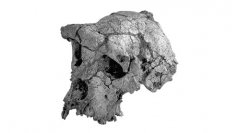

 Comptes Rendus Palevol
3 (4) - Pages 277-285
Comptes Rendus Palevol
3 (4) - Pages 277-285The new Chadian hominid Sahelanthropus tchadensis Brunet et al., 2002, nicknamed ‘Toumaï’, recovered by the MPFT ( Mission paléoanthropologique franco-tchadienne , scientific collaboration between the University of Poitiers, University of N’Djamena and CNAR, National Center for the support of Science of N’Djamena) from the Late Miocene of Toros-Menalla (Djurab desert) is associated with a vertebrate fauna (more than 45 species) for which the mammalian component (at least 25 species) indicates a biochronological age close to 7 Ma. The fauna comprises vertebrates that are aquatic (fish, turtles, crocodiles) and amphibious (anthracotheriids, hippopotamids) but also species adapted to the gallery and islet forests (monkeys), wooded savanna (proboscideans, giraffids, suids, etc) and grassland (bovids, tridactyl equids). Sedimentological data (aeolian sandstones, perilacustrine sandstones, diatomites) agree with this mosaic of environments and indicate a vegetated perilacustrine belt between lake and desert. The new hominid is probably temporally close to the common ancestor of chimpanzees and humans but displays a unique combination of primitive and derived characters that clearly shows a close relationship with later hominids rather than with chimpanzees or gorilla. The geographic location of Toumaï, 2500 km west of the Rift Valley, along with its great antiquity, suggest an early widespread hominid distribution (Sahel and East Africa, at least by 6 Ma), and a somewhat earlier chimpanzee-human divergence (at least by 7 Ma ago) than previously indicated by many molecular studies.
Early hominid, Upper Miocene, Central Africa, Chad